Ijraset Journal For Research in Applied Science and Engineering Technology
- Home / Ijraset
- On This Page
- Abstract
- Introduction
- Conclusion
- References
- Copyright
Semi-Automatic Solar Powered Grass Cutter
Authors: Abhishek Pawar, Anushka Bhalerao, Ruturaj Tagunde, Nikita Undirwade
DOI Link: https://doi.org/10.22214/ijraset.2022.46982
Certificate: View Certificate
Abstract
Due to the constant rise in fuel prices and the impact of gas emissions from burned fuel into the atmosphere, it became necessary to use the sun\'s plentiful solar energy as a source of electricity to operate a lawn cutter. Based on the fundamental idea of mowing, a solar-powered lawn cutter was created. Direct current (DC) motor, rechargeable battery, solar panel, stainless-steel blade, and control switch make up the solar-powered lawn cutter\'s design. The DC motor, which is directly connected to the shaft of the DC motor and provides the necessary torque to drive the stainless steel blade, is used to mow the lawn. The switch on the board, which shuts the circuit and permits electricity to pass to the motor, which in turn drives the blade used for mowing, is used to operate the solar-powered lawn cutter. The system will use some automation for obstacle identification and direction. A solar panel will be fixed to the top of the robot and serve as the system\'s power source in addition to a battery. Nobody like moving the lawn cutters when they are driven by a normal motor since it is a hassle. Elderly or younger people may find it difficult to cut the grass since a lawn cutter moving with an engine produces both local air pollution from engine combustion and noise pollution owing to the noisy engine. A motor-powered engine also needs routine maintenance, including changing the oil. Despite being ecologically beneficial, electrified solar grass may still be a pain. Electric grass cutters, like motor-powered ones, are dangerous and difficult for everyone to use. Additionally, if the electric lawn cutter is tethered, cutting might be difficult and dangerous. The prototype will also use solar panels to charge from the sun.
Introduction
I. INTRODUCTION
Large areas of grass are manually maintained at parks, schools, and colleges. Regular grass cutting and maintenance required the gardener to use hand scissors, which also takes more time. Maintaining consistent size is challenging and not at all simple. Because of the reduced power usage, this method may be used to create a solar lawn cutter without a power supply. The solar grass cutter may be used by a novice gardener. Today, grass cutting machines are quite common. The majority of the time, soft grass landscaping is done with grass cutter equipment. Consumers are seeking for methods to reduce the impact of their personal cart footprints in a time when technology and environmental consciousness are blending. Man-made pollution may be seen in our everyday lives, more especially in our own houses. Here, we suggest a design for an autonomous grass-cutting device that uses solar electricity (renewable energy). A machine that will cut the grass on its own is known as an automatic lawn cutting machine. This design lessens noise and environmental pollutants. Both the customer and the environment will benefit from our innovative design for an antiquated behaviour. The consumer will not have to mow their own lawn, and both noise and environmental pollution will be reduced. This project is a solar-powered automated grass cutter that is intended to be an alternative to the common and ecologically risky fuel-powered grass cutters. In the end, consumers will be contributing to the environment more while putting in less effort each day.
A. Objectives
The operating principles of the many automated grass cutters now in use vary. For example, the Rob mow from Friendly Robotics (2011) involves a one-time setup during which the garden border is established. The perimeter is established by laying a battery-powered wire around the warden's outside limits and any other place that the robot is not supposed to patrol. Rob mow has special sensors that can identify the wires, keeping the robot inside the allotted space.
B. Problem Statement
- No one like moving the lawn cutters with a conventional motor since it is inconvenient.
- Due to engine combustion, traditional lawn cutters with powerful engines produce noise pollution and localised air pollution.
- Engines that are powered by motors need routine maintenance, such as changing the engine oil. When using a corded electric lawn cutter, moving about might be difficult and dangerous.
C. Solution
The creation of a low-cost automated grass cutter powered by electricity generated from renewable energy sources, such as solar energy, is the solution to the aforementioned issue. Environmental pollutants and noise pollution are decreased because no fuel or engine is utilised. Future potential for more automation.
D. Design Method Consideration
It is estimated from current technology that the general architecture of the system detailed in this report would have to work with the following considerations in order to generate an end result that is better than that which is now available and at a reduced cost: It would be necessary to design the system such that it follows a certain path and uses a more effective cutting pattern.
- An alternative to the guide wire for regulating the size of gardens that can be more cost-effective, durable, and long-lasting.
- Effective cutting techniques.
- A more cost-effective sensor array configuration that would make it possible to determine garden limits and obstacles.
- A two-wheeled vehicle would make it easier for the robot to go around the track than any other kind.
It should be decided that all electronics are on board and that the device is capable of determining all necessary parameters in this way, as opposed to the robot relying on extra electronics put up in the garden area.
II. LITERATURE REVIEW
- Ashish Kumar Chaudhari: They have created a manually operated equipment that can cut grass in this paper. This gadget is made of linear blades and is not affected by the weather. The following ingredients were used to prepare the lawn cutter. When a barrier appears in front of the grass cutter, the IR sensor detects it and sends a signal to the microcontroller telling it to adjust course or halt cutting grass until the barrier is gone. The main goal of this paper is to make numerous designs by moving the grass cutter in different directions based on the needs. You may change the cut's height by utilising a link technique. This gadget is simply operated by unskilled labour.
- Vicky Jain: They have a wireless grass trimmer ready. The two primary parts are the transmitter and the receiver. If there is an obstruction in front of the grass cutter, the transmitter constantly sends the rays, which are then reflected back toward the receiver. The signals are received by the receiver in serial form by the encoder, but the microcontroller needs parallel data to communicate, thus the receiver passes the signals to the decoder, which converts the signals into parallel form before passing them to the microcontroller. Because they employed a solar panel, the battery does not need to be charged externally and is continually charged at a steady voltage while the lawn cutter is operating. The battery is stored and charged throughout the day using a solar panel, allowing us to use the lawn cutter at night as well. Due to two DC motors, the grass cutter is capable of moving both forward and backward at once.
- Ashish Kumar Chaudhari: The author of this paper explains how a solar plate placed above a grass cutter produces solar energy and uses that energy to operate the grass cutter. Additionally, a driver circuit is used to adjust the motor's speed based on the situation. Grass cutters are prepared using solar panels, batteries, DC motors, solar chargers, circuits, and blades. Regulator is incorporated into the system and ought to be connected in series with the battery to prevent it from being overcharged and overdischarged.
- Pankaj Malvivas: The author made a manual device. A DC motor that can be controlled is utilised to change the direction of the grass cutter as needed, and the battery may be charged using both a solar panel and an external power source. The most common regulator is used to stop overcharging and draining of batteries, extending their lifespan. Solar energy is the ideal alternative to electricity since industrialisation has increased the need for power in numerous industrial applications and electrical devices. These parts are used to construct a lawn cutter: solar panel, battery, DC motor, solar charger. There is less maintenance because they employed fewer moving parts. This lawnmower will provide the user with considerably more physical workout and be simple to use.
- Praful P. Ulhe: Because spiral blades improve cutting efficiency, they created a manually driven lawn cutter with spiral roller blades for this article. Reel cutter is a component attached to the grass cutter for height adjustment. This grass cutter can cut a variety of grass varieties and used to cut grass consistently. The battery has both AC and working-condition charging capabilities. A cutting box is placed over the grass cutter to collect the chopped grass, which is then spread outside the turf. It is both lightweight and small in size.
III. METHODOLOGY AND WORKING PRINCIPLE
A. Methodology
- Grass Cutter will have automated control capabilities. It will contain wheels that regulate turning and forward and backward movement of the lawn cutter, solar station, and control unit.
- Grass cutter batteries are charged by solar energy. When the battery is fully charged, it automatically turns off. Other components (solar panel, power management circuit, motors for blades and wheels) are interacted with and controlled by a microcontroller.
B. Components Used
- Solar panel and solar charger: The solar panel has a 17.65 volt rated voltage, a 0.62 amp rated current, and a 10 watt rated peak power. Whereas the maximum input power and voltage for a solar charger is 260 W at 12 V.
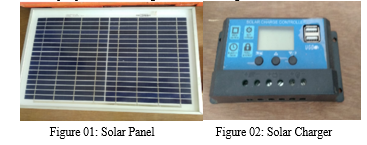
Source:- Field Survey
2. Customised Blade for Cutting the Grass and Battery: Because of its strength and weight, low carbon CR steel ASTM A36 was chosen in the building of the cutting blade. This steel can transmit speed at a similar rate to that of a DC motor with a little less friction. Figure 04 shows the battery which is used in this project. Specifications of the battery are 12V 3Ah.
a. Blade Design
The force necessary to cut the lawn as well as the force on the blade were taken into account when constructing the cutting blade. Any sharp object must impact the grass with less than 10 Newtons of force in order to do so. It also depends on the object's height, density, and surface area. The force needed for effective mowing should therefore be larger than 10 tonnes when building the blade of the solar tiered grass cutter. Because of its weight and strength, Low Carbon CR Steel ASTM A36 was utilised to build the cutting blade, which can transmit speed at a level comparable to that of a DC motor or with somewhat less friction.
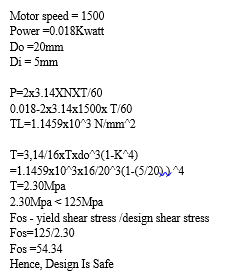
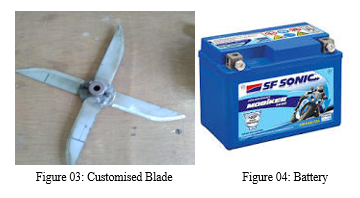
Source:- Field Survey
3. 12 V DC Gear Motor for Wheels and Blade Motor for Blade Movement: Wheels with shaft lengths of 30 mm were driven by 12 V DC gear motors With rated speeds of 33 rpm and 25.4 N-mm of torque. For the Blade DC motor, the power is 350 rpm, the voltage is 12 V, and the shaft length is 30 mm. The rated torque is 215.7 N-mm.
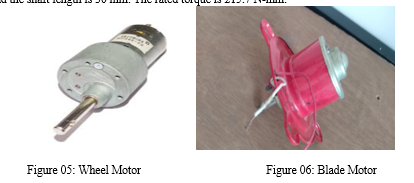
Source:- Field Survey
4. Arduino UNO and L298n Motor Driver: The functionalities of the Arduino UNO include: 5 Volts, operating voltage 7 to 20 volts as the input voltage I/O Pins for Digital: 14 (of which 6 can provide PWM output) 6 DC Analog Input Pins I/O current per Pin: 20 mA . DC Current at 3.3 volts Pin: 50 mA Size: 68.6 mm Dimensions 53.4 mm wide Size: 25 g. Whereas, The features of the L298n motor driver are as follows: 2 and 3 motor channels Peak output current per channel is 2A, maximum working voltage is 46 V, and Minimum and maximum logic voltages are 4.5 and 7 volts, respectively.
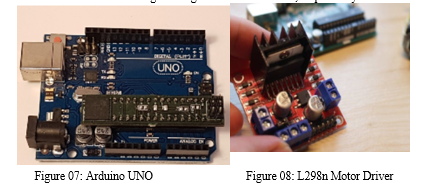
Source:- Field Survey
5. Bluetooth Module and Ultrasonic Sensor: The Bluetooth module has the following specifications: Operating Voltage: 4V to 6V (often +5V), Operating Current: 30mA, and Range: around 100m. In contrast, the characteristics of an ultrasonic sensor are as follows: input voltage of 5 volts, maximum current draw of 20 milliamperes, digital output of 5 volts, low digital output of 0 volts, operating temperature of -15 °C to 70 °C, sensing angle of 30 ° cone, and effect angle of 15 ° cone.

Source:- Field Survey
6. Wheels and PVC Pipes with Joints for the Body: The wheels have the following measurements: Dim: 10 cm x 4 cm, Diameter of shaft hole: 6 mm. Figure 11 shows the body of the project which is made using PVC pipes and joints where the base of the project is made of plywood as shown in figure 13 and 14 respectively.
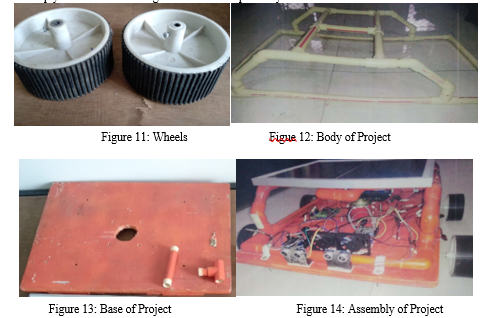
Source:- Field Survey
C. Working Principle
The way a solar grass cutter works is that it has panels installed in a specific configuration so that it can easily receive solar radiation of high intensity from the sun. Solar energy is transformed into electrical energy by these solar panels. By utilising a solar charger, this electrical energy is put into batteries for storage. The solar charger's primary job is to boost the current coming from the panels while the batteries are charging. It also disconnects the panels from the batteries when the batteries are fully charged and reconnects them when the batteries are only partially charged. Through connecting wires, the motor is linked to the batteries. There is a provision between these two mechanical circuit breaker switches. The intended solar-powered grass cutter consists of a spring-steel blade, a control switch, a rechargeable battery, and a direct current (D.C) motor. The spring steel blade, which is directly connected to the D.C. motor's shaft, is driven by the DC motor, which supplies the necessary torque.
- Wireless remote controlling the apparatus.
- Responds to human commands to move ahead or backward.
- Automatically move forward and take a turn utilising the ultrasonic sensor whenever there is an obstruction.
- Consists of four different motors coupled by wheels that can travel forward and backward on the grass.
- Consists of four different motors coupled by wheels that can travel forward and backward on the grass.
- A set of blades in the device's interior are used to cut the grass.
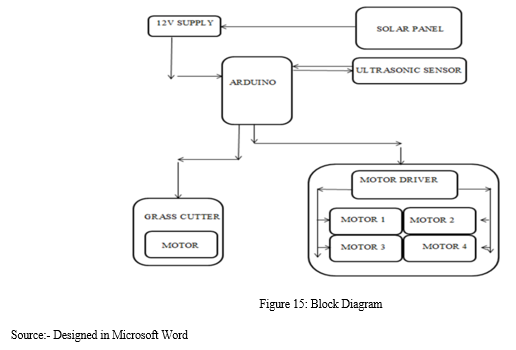
IV. FUTURE SCOPE
- Aluminum can be used in place of plastic to lighten lawn mower’s weight.
- The blade can be changed from the ground by using the rack and pinion mechanism.
- The solar panel can be turned so that it faces the sun by utilising the servo motor.
- It may also operate the solar grass cutter in the frame by turning the pointed wheel.
- It can be made smaller and more compact.
- Increasing battery capacity can increase efficiency.
- More sensors can be added to increase automation and result accuracy.
- Programming can be improved to enable the device to carry out additional tasks.
Conclusion
This system is very simple to operate and advantageous overall because it has fewer moving parts and can be fueled by solar energy, which means there are no fuel costs, no pollution, and no fuel residue. It can be resolved easily. This technology has the capacity to recharge the battery while the solar energy is used to cut the grass. As a result, cutting grass is much easier using it. Reduced costs, better blade efficiency, and less weight can all raise this project\'s productivity. The sensors are unaffected by the environment or animals. It is really beneficial to the user. The DC motor maintains consistent speed when used in load settings. The solar panel consistently charges the battery. As a voltage regulator, Arduino used a distinct input from the photovoltaic panels to stabilise performance despite the fact that the output of the solar panels varies.
References
[1] Darwin Ramos and Jessie Lucero proposed solar powered automatic lawn mower Sanjose state university, electrical dept la 2009. [2] Guo-shing Huang und Keng-Chih Lin proposed “Intelligent auto saving energy robotic lawn mower & quot; IEEE transaction on robotics. Pg. 4130 to 4136 In 2010. [3] Tanimola Department of Agricultural & amp; Bio Environmental Engineering Lag State Polytechnic Ikorodu, Nigeria Volume 5, issue 6, June 2014 ISSN 2229-5518. [4] Amons (2013) Electricity Generation from Solar Energy, Technology and Economic Woodbank Communication Ltd. South Crescent Road, Chester CH4 TAU United Kingdom. [5] Vishal Dave Electronics Department KC College Of Engineering & Management Studies & Research Kopri, Thane (E). Maharashtra, India ISSN 2120-8163, Special Issue 39 (KCCEMSR) (March 2016), PP 3943. [6] Design and implementation of autonomous Lawn Mower Robot controller" [7] Non-Conventional Energy sources by GDRAI, Khanna Publishers.
Copyright
Copyright © 2022 Abhishek Pawar, Anushka Bhalerao, Ruturaj Tagunde, Nikita Undirwade. This is an open access article distributed under the Creative Commons Attribution License, which permits unrestricted use, distribution, and reproduction in any medium, provided the original work is properly cited.

Download Paper
Paper Id : IJRASET46982
Publish Date : 2022-10-05
ISSN : 2321-9653
Publisher Name : IJRASET
DOI Link : Click Here
 Submit Paper Online
Submit Paper Online

